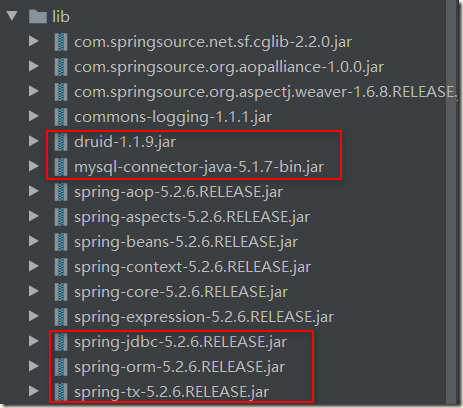Spring(六)-JdbcTemplate
一、JdbcTemplate使用
Spring 框架对 JDBC 进行封装,使用 JdbcTemplate 方便实现对数据库操作
1.1、准备工作
1)引入相关jar包
2)配置数据库连接信息
prop.driverClass=com.mysql.jdbc.Driver prop.url=jdbc:mysql://localhost:3306/mybatis prop.userName=root prop.password=123456
3)spring配置文件
<!--引入外部资源--> <context:property-placeholder location="classpath:jdbc.properties"></context:property-placeholder> <!--配置数据库连接池--> <bean id="dataSource" class="com.alibaba.druid.pool.DruidDataSource"> <property name="url" value="${prop.url}" /> <property name="username" value="${prop.userName}" /> <property name="password" value="${prop.password}" /> <property name="driverClassName" value="${prop.driverClass}" /> </bean> <!--配置JdbcTemplate对象并注入datasource--> <bean id="jdbcTemplate" class="org.springframework.jdbc.core.JdbcTemplate"> <!--注入dataSource--> <property name="dataSource" ref="dataSource"></property> </bean>
4)测试数据库连接
@Test public void testConnection() throws SQLException { ApplicationContext context = new ClassPathXmlApplicationContext("bean3.xml"); DruidDataSource dataSource = context.getBean("dataSource", DruidDataSource.class); System.out.println(dataSource.getConnection()); }

1.2、创建相关类
1)创建数据库表
CREATE TABLE IF NOT EXISTS `book`( `id` INT AUTO_INCREMENT, `name` VARCHAR(100) NOT NULL, `status` VARCHAR(100) NOT NULL, PRIMARY KEY ( `id` ) )ENGINE=InnoDB DEFAULT CHARSET=utf8;
2)创建实体类
package com.dianchou.spring.jdbc; /** * @author lawrence * @create 2020-07-08 17:02 */ public class Book { private Integer id; private String name; private String status; public Integer getId() { return id; } public void setId(Integer id) { this.id = id; } public String getName() { return name; } public void setName(String name) { this.name = name; } public String getStatus() { return status; } public void setStatus(String status) { this.status = status; } @Override public String toString() { return "Book{" + "id=" + id + ", name='" + name + '\'' + ", status='" + status + '\'' + '}'; } }
3)创建dao及service
BookDao:
package com.dianchou.spring.jdbc; import java.util.List; /** * @author lawrence * @create 2020-07-08 18:28 */ public interface BookDao { public void addBook(Book book); public void deleteById(Integer id); public Integer getCount(); public Book findBookById(Integer id); public List<Book> findAllBooks(); public void batchAdd(List<Object[]> batchArgs); public void batchUpdate(List<Object[]> batchArgs); public void batchDelete(List<Object[]> batchArgs); }
BookDaoImpl:
package com.dianchou.spring.jdbc; import org.springframework.beans.factory.annotation.Autowired; import org.springframework.jdbc.core.BeanPropertyRowMapper; import org.springframework.jdbc.core.JdbcTemplate; import org.springframework.stereotype.Repository; import java.util.Arrays; import java.util.List; /** * @author lawrence * @create 2020-07-08 18:29 */ @Repository public class BookDaoImpl implements BookDao{ @Autowired private JdbcTemplate jdbcTemplate; @Override public void addBook(Book book) { String sql = "insert into book(name,status) values(?,?)"; Object[] args = {book.getName(),book.getStatus()}; int updateCount = jdbcTemplate.update(sql, args); System.out.println(updateCount); } @Override public void deleteById(Integer id) { String sql = "delete from book where id=?"; int deleteCount = jdbcTemplate.update(sql, id); System.out.println(deleteCount); } @Override public Integer getCount() { String sql = "select count(*) from book"; Integer count = jdbcTemplate.queryForObject(sql, Integer.class); return count; } /** *第一个参数:sql 语句 *第二个参数:RowMapper 是接口,针对返回不同类型数据,使用这个接口里面实现类完成数据封装 *第三个参数:sql 语句值 */ @Override public Book findBookById(Integer id) { String sql = "select * from book where id=?"; Book book = jdbcTemplate.queryForObject(sql, new BeanPropertyRowMapper<Book>(Book.class), id); return book; } @Override public List<Book> findAllBooks() { String sql = "select * from book"; List<Book> books = jdbcTemplate.query(sql, new BeanPropertyRowMapper<Book>(Book.class)); return books; } @Override public void batchAdd(List<Object[]> batchArgs) { String sql = "insert into book(name,status) values(?,?)"; int[] ints = jdbcTemplate.batchUpdate(sql, batchArgs); System.out.println(Arrays.toString(ints)); } @Override public void batchUpdate(List<Object[]> batchArgs) { String sql = "update book set name=?,status=? where id=?"; int[] ints = jdbcTemplate.batchUpdate(sql, batchArgs); System.out.println(Arrays.toString(ints)); } @Override public void batchDelete(List<Object[]> batchArgs) { String sql = "delete from book where id=?"; int[] ints = jdbcTemplate.batchUpdate(sql, batchArgs); System.out.println(Arrays.toString(ints)); } }
BookService:
package com.dianchou.spring.jdbc; import org.springframework.beans.factory.annotation.Autowired; import org.springframework.stereotype.Service; import java.util.List; /** * @author lawrence * @create 2020-07-08 18:29 */ @Service public class BookService { @Autowired private BookDao bookDao; public void addBook(Book book){ bookDao.addBook(book); } public void deleteBook(Integer id){ bookDao.deleteById(id); } public void getCount(){ Integer count = bookDao.getCount(); System.out.println(count); } public void findBookById(){ Book book = bookDao.findBookById(1); System.out.println(book); } public void findAllBooks(){ List<Book> books = bookDao.findAllBooks(); System.out.println(books); } public void batchAdd(List<Object[]> batchArgs){ bookDao.batchAdd(batchArgs); } public void batchUpdate(List<Object[]> batchArgs){ bookDao.batchUpdate(batchArgs); } public void batchDelete(List<Object[]> batchArgs){ bookDao.batchDelete(batchArgs); } }
4)测试
package com.dianchou.spring.jdbc; import com.alibaba.druid.pool.DruidDataSource; import org.junit.Test; import org.springframework.context.ApplicationContext; import org.springframework.context.support.ClassPathXmlApplicationContext; import org.springframework.jdbc.core.JdbcTemplate; import java.sql.SQLException; import java.util.ArrayList; import java.util.List; /** * @author lawrence * @create 2020-07-08 16:12 */ public class JdbcTemplateTest { @Test public void testConnection() throws SQLException { ApplicationContext context = new ClassPathXmlApplicationContext("bean3.xml"); DruidDataSource dataSource = context.getBean("dataSource", DruidDataSource.class); System.out.println(dataSource.getConnection()); } @Test public void testAdd(){ ApplicationContext context = new ClassPathXmlApplicationContext("bean3.xml"); BookService bookService = context.getBean("bookService", BookService.class); Book book = new Book(); // book.setId(4); book.setName("水浒传"); book.setStatus("OK"); bookService.addBook(book); } @Test public void testDelete(){ ApplicationContext context = new ClassPathXmlApplicationContext("bean3.xml"); BookService bookService = context.getBean("bookService", BookService.class); bookService.deleteBook(3); } @Test public void testCount(){ ApplicationContext context = new ClassPathXmlApplicationContext("bean3.xml"); BookService bookService = context.getBean("bookService", BookService.class); bookService.getCount(); } @Test public void testFindBookById(){ ApplicationContext context = new ClassPathXmlApplicationContext("bean3.xml"); BookService bookService = context.getBean("bookService", BookService.class); bookService.findBookById(); } @Test public void testFindAllBooks(){ ApplicationContext context = new ClassPathXmlApplicationContext("bean3.xml"); BookService bookService = context.getBean("bookService", BookService.class); bookService.findAllBooks(); } @Test public void testBatchAdd(){ ApplicationContext context = new ClassPathXmlApplicationContext("bean3.xml"); BookService bookService = context.getBean("bookService", BookService.class); List<Object[]> batchArgs = new ArrayList<>(); Object[] o1 = {"Java","OK"}; Object[] o2 = {"Python","OK"}; Object[] o3 = {"C++","OK"}; batchArgs.add(o1); batchArgs.add(o2); batchArgs.add(o3); bookService.batchAdd(batchArgs); } @Test public void testBatchUpdate(){ ApplicationContext context = new ClassPathXmlApplicationContext("bean3.xml"); BookService bookService = context.getBean("bookService", BookService.class); List<Object[]> batchArgs = new ArrayList<>(); Object[] o1 = {"Java","OK",1}; Object[] o2 = {"Python","OK",2}; Object[] o3 = {"C++","OK",3}; batchArgs.add(o1); batchArgs.add(o2); batchArgs.add(o3); bookService.batchUpdate(batchArgs); } @Test public void testBatchDelete(){ ApplicationContext context = new ClassPathXmlApplicationContext("bean3.xml"); BookService bookService = context.getBean("bookService", BookService.class); List<Object[]> batchArgs = new ArrayList<>(); Object[] o1 = {1}; Object[] o2 = {2}; Object[] o3 = {3}; batchArgs.add(o1); batchArgs.add(o2); batchArgs.add(o3); bookService.batchDelete(batchArgs); } }
作者:Lawrence
-------------------------------------------
个性签名:独学而无友,则孤陋而寡闻。做一个灵魂有趣的人!

扫描上面二维码关注我
如果你真心觉得文章写得不错,而且对你有所帮助,那就不妨帮忙“推荐"一下,您的“推荐”和”打赏“将是我最大的写作动力!
本文版权归作者所有,欢迎转载,但未经作者同意必须保留此段声明,且在文章页面明显位置给出原文连接.



